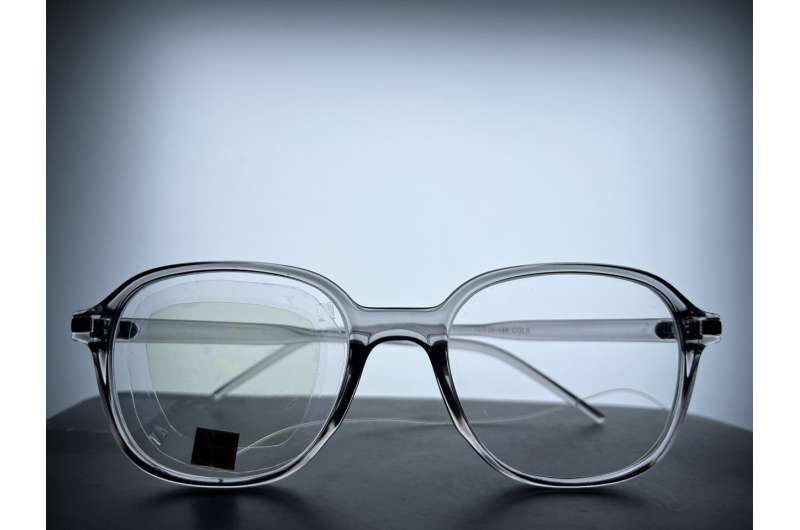This article has been reviewed according to Science X's editorial process and policies. Editors have highlighted the following attributes while ensuring the content's credibility:
fact-checked
peer-reviewed publication
trusted source
proofread
New flexible film detects eyelash proximity in blink-tracking glasses

When another person's finger hovers over your skin, you may get the sense that they're touching you, feeling not necessarily contact, but their proximity. Similarly, researchers reporting in ACS Applied Materials & Interfaces have designed a soft, flexible film that senses the presence of nearby objects without physically touching them. The study features the new sensor technology to detect eyelash proximity in blink-tracking glasses.
Non-contact sensors can identify or measure an object without directly touching it. Examples of these devices include infrared thermometers and vehicle proximity notification systems. One type of non-contact sensor relies on static electricity to detect closeness and small motions, and has the potential to enhance smart devices, such as allowing phone screens to recognize more finger gestures.
So far, however, they've been limited in what types of objects get detected, how long they stay charged and how hard they are to fabricate. So, Xunlin Qiu, Yiming Wang, Fuzhen Xuan and coworkers wanted to create a flexible static electricity-based sensor that overcame these problems.
The researchers began by simply fabricating a three-part system: fluorinated ethylene propylene (FEP) for the top sensing layer, with an electrically conductive film and flexible plastic base for the middle and bottom layers, respectively.
FEP is an electret, a type of material that's electrically charged and produces an external electrostatic field, similar to the way a magnet produces a magnetic field. Then they electrically charged the FEP-based sensor making it ready for use.
As objects approached the FEP surface, their inherent static charge caused an electrical current to flow in the sensor, thereby "feeling" the object without physical contact. The resulting clear and flexible sensor detected objects—made of glass, rubber, aluminum and paper—that were nearly touching it but not quite, from 2 to 20 millimeters (less than an inch) away. The sensor held its charge for over 3,000 different approach-withdraw cycles over almost two hours.
In a demonstration of the new sensing film, the researchers attached it to the inner side of an eyeglass lens. When worn by a person, the glasses noticed the approach of eyelashes and identified when the wearer blinked Morse code for "E C U S T," the abbreviation for the researchers' institution.
In the future, the researchers say their non-contact sensors could be used to help people who are unable to speak or use sign language communicate or even detect drowsiness when driving.
More information: Facile Electret-Based Self-Powered Soft Sensor for Noncontact Positioning and Information Translation, ACS Applied Materials & Interfaces (2024). DOI: 10.1021/acsami.4c02741




















